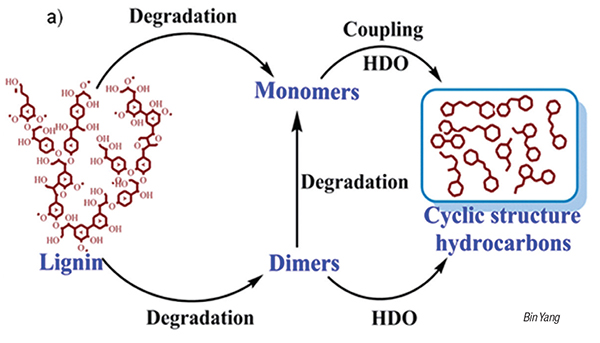Innovative Hydrogen Storage Solution using Lignin-Based Jet Fuel
Key Ideas
- Researchers from WSU and PNNL developed a lignin-based jet fuel as a liquid organic hydrogen carrier (LOHC) for efficient high-density hydrogen storage.
- Platinum nanoparticles supported on zeolite catalysts enable the lignin jet fuel to undergo dehydrogenation, forming LJF-HyC as a potential liquid hydrogen storage medium.
- The LJF-HyC could facilitate easy hydrogen storage and transportation, offering promising opportunities for compatibility with existing infrastructure and enhancing efficiency and sustainability of sustainable aviation fuel (SAF) and hydrogen technologies.
- The researchers are focused on reducing the cost of catalyst manufacturing to make the process more economically viable for scalable production.
A team of researchers from Washington State University (WSU) and Pacific Northwest National Laboratory (PNNL) in Richland, Washington, have developed an innovative solution for hydrogen storage using a lignin-based jet fuel as a liquid organic hydrogen carrier (LOHC). By utilizing platinum nanoparticles supported on zeolite catalysts, the lignin jet fuel undergoes a dehydrogenation process to transform into LJF-HyC, a liquid hydrogen storage medium.
The study revealed that LJF-HyC contains significant aromatic species, making it a potential candidate for high-density hydrogen storage. The LOHC can store and transport hydrogen effectively, releasing it at the point of use through a catalytic process. The researchers believe that this approach using LJF as a LOHC not only enables efficient storage but also promotes sustainable aviation fuel (SAF) by enhancing compatibility with existing infrastructure.
Published in the International Journal of Hydrogen Energy, the researchers emphasize the economic viability and scalability of the process, aiming to create a synergistic system that improves efficiency, safety, and sustainability in the aviation and hydrogen sectors. While the focus remains on catalyst manufacturing cost reduction, the development shows promising opportunities for advancing hydrogen technologies and promoting a more sustainable energy future.
